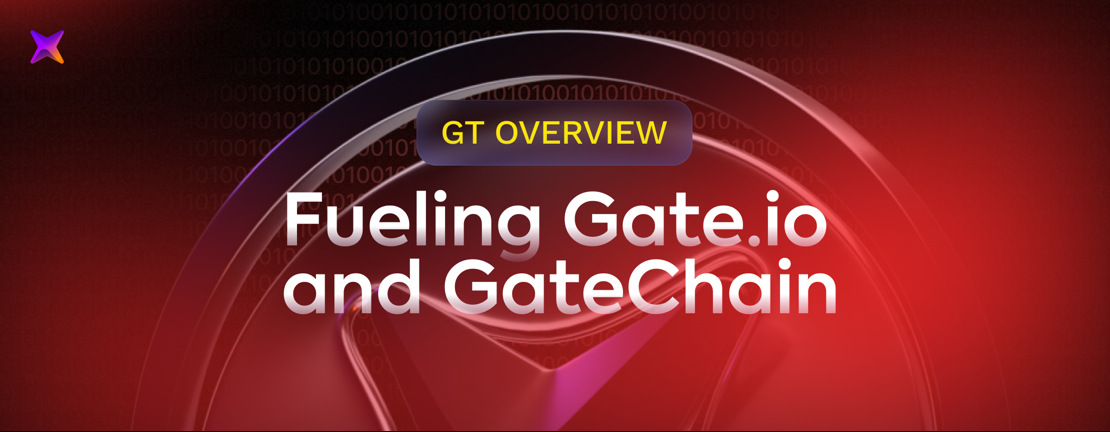Published 09 Oct 2025
Gate Token (GT): Linking Exchange and Blockchain

Gate Token (GT) is the native exchange token of Gate.io, one of the longest-running cryptocurrency platforms established in 2013. GT plays a dual role in the ecosystem. It works as a utility token within the centralized Gate.io exchange and as the native asset powering GateChain, the blockchain developed by the same company. This dual purpose makes GT one of the few exchange tokens that bridge centralized trading services with decentralized infrastructure. The token is backed by a deflationary model, consistent token burns, and integration across a wide range of exchange and on-chain functions. Together, these features position GT as a core element in Gate.io’s strategy to connect traditional exchange users with blockchain-based applications.
Defining GT: The Core of Gate.io’s Ecosystem
Gate Token (GT) was introduced in 2019 as the native token of Gate.io. It was designed to support both the exchange’s operations and its blockchain ecosystem, GateChain. On the exchange side, GT functions as a utility token that provides trading fee discounts, access to VIP tiers, and participation in token sales. On the blockchain side, it serves as the gas token for transactions, smart contracts, and decentralized applications running on GateChain.
GT’s supply is managed through a deflationary model that includes periodic token burns and a buyback mechanism funded by exchange revenues. Since its launch, the token’s total supply has been significantly reduced, making scarcity one of its defining features. This combination of utility, governance, and supply reduction positions GT as more than a simple exchange discount token — it has become a key asset within Gate.io’s broader ecosystem.
Inside the Tech: How GateChain Powers GT
Gate Token (GT) is closely tied to GateChain, the blockchain developed by Gate.io. GateChain uses a Proof-of-Stake consensus model supported by a network of global validators. This design ensures efficiency, low energy consumption, and strong security. Validators are required to stake GT as collateral, which aligns their incentives with the stability of the network.
One of GateChain’s most distinctive features is its Vault Account system. Vaults allow users to set a delay period for transactions, giving them time to reverse transfers if private keys are compromised. This mechanism adds an extra layer of protection against asset theft and is uncommon among other blockchains.
The network is fully compatible with the Ethereum Virtual Machine (EVM), which allows developers to migrate applications and smart contracts with minimal changes. GateChain also supports cross-chain transfers, NFT minting, and Layer 2 scaling through Gate Layer. The Layer 2 solution processes thousands of transactions per second at very low fees, making it competitive with other high-performance blockchain infrastructures.
Tokenomics of GT: Supply, Burns, and Utility
Gate Token (GT) was launched with an initial supply of 1 billion tokens, later adjusted to a maximum cap of 300 million. Since 2019, Gate.io has carried out regular burns that have permanently removed more than half of this supply from circulation. These burns are funded through a buyback program that uses a percentage of the exchange’s revenue, making GT one of the most deflationary exchange tokens in the market.
GT’s economic model combines several mechanisms. Holders benefit from trading fee discounts and access to higher VIP tiers on Gate.io. The token also powers staking rewards on GateChain, where participants secure the network and earn returns. In addition, GT is required for governance voting, startup participation, and other platform activities.
This design creates steady demand for GT across both centralized and decentralized platforms. The ongoing reduction in circulating supply, paired with its wide-ranging use cases, supports the token’s role as a long-term asset in the Gate ecosystem.
From 2013 to Today: Gate.io’s Path and GT’s Origins
Gate.io was founded in 2013, making it one of the earliest cryptocurrency exchanges still in operation. Over the years, the platform expanded its services from basic spot trading to derivatives, lending, staking, and decentralized finance products. To strengthen its ecosystem, the exchange introduced Gate Token (GT) in 2019 as part of the launch of GateChain.
The team behind Gate.io and GateChain consists of developers, security experts, and financial professionals focused on building a platform that integrates both centralized and decentralized solutions. Their work on GateChain introduced innovations such as Vault Accounts, revocable transactions, and full EVM compatibility.
Through continuous updates and token burns, the team has shaped GT into more than a fee-discount token. It has become a core element connecting Gate.io’s centralized exchange with its decentralized infrastructure, reflecting the company’s strategy of bridging traditional trading platforms with blockchain technology.
How GT Works Across Exchange and Chain
Gate Token (GT) serves a broad range of functions across both the Gate.io exchange and the GateChain blockchain. On the exchange, GT is used for trading fee discounts, access to higher VIP tiers, and participation in early-stage token offerings through the Startup platform. These utilities make GT central to the trading experience, rewarding long-term users with cost savings and exclusive opportunities.
On GateChain, GT operates as the native gas token. It powers all on-chain activities, including transfers, smart contract deployments, cross-chain operations, and NFT minting. Staking GT secures the network through Proof-of-Stake consensus, while also offering holders the chance to earn rewards. Governance rights further expand its role, allowing the community to vote on platform upgrades and project listings.
This dual functionality enables GT to connect centralized and decentralized finance in a single ecosystem. By linking exchange benefits with blockchain infrastructure, GT provides practical value to traders, developers, and long-term investors alike.
Where GT Stands Among Exchange Tokens
Gate Token (GT) belongs to the category of exchange tokens, alongside assets such as Binance Coin (BNB), OKB, and Huobi Token (HT). Like its peers, GT offers trading discounts, VIP access, and governance rights on the exchange. What sets it apart is its deeper integration with GateChain, a dedicated blockchain where GT serves as the native gas token. This dual role expands its utility beyond the exchange itself.
In terms of market position, GT is smaller in capitalization compared to BNB or OKB, but its aggressive deflationary model and consistent token burns have helped it maintain value relative to supply. The token’s link to GateChain also provides differentiation, as it supports decentralized applications, staking, and advanced security features like Vault Accounts.
As competition among exchange tokens continues, GT’s strength lies in combining exchange-based benefits with blockchain-level functionality. This positions it as both a utility token for traders and a core asset within a growing decentralized infrastructure.
Final Takeaways on GT’s Role in the Market
Gate Token (GT) has developed into more than a standard exchange discount asset. Since its launch in 2019, it has become a cornerstone of Gate.io’s strategy to combine centralized services with decentralized infrastructure. On the exchange, it provides clear benefits such as lower trading fees, VIP upgrades, and access to early token offerings. On GateChain, it powers the entire blockchain as the native gas token, enabling staking, governance, and on-chain applications.
The token’s deflationary model — with consistent burns and buybacks — has steadily reduced supply, strengthening its long-term position in the market. Technical features like Vault Accounts, Proof-of-Stake consensus, and full EVM compatibility further enhance the blockchain side of the ecosystem.
In the broader landscape of exchange tokens, GT may not be the largest by market capitalization, but its dual role gives it unique relevance. By connecting traditional trading activity with blockchain-based applications, GT represents a hybrid approach that continues to evolve with the growth of both Gate.io and GateChain.
Read More




 Get RateX Pro
Get RateX Pro

 06 Jun 2024
06 Jun 2024
